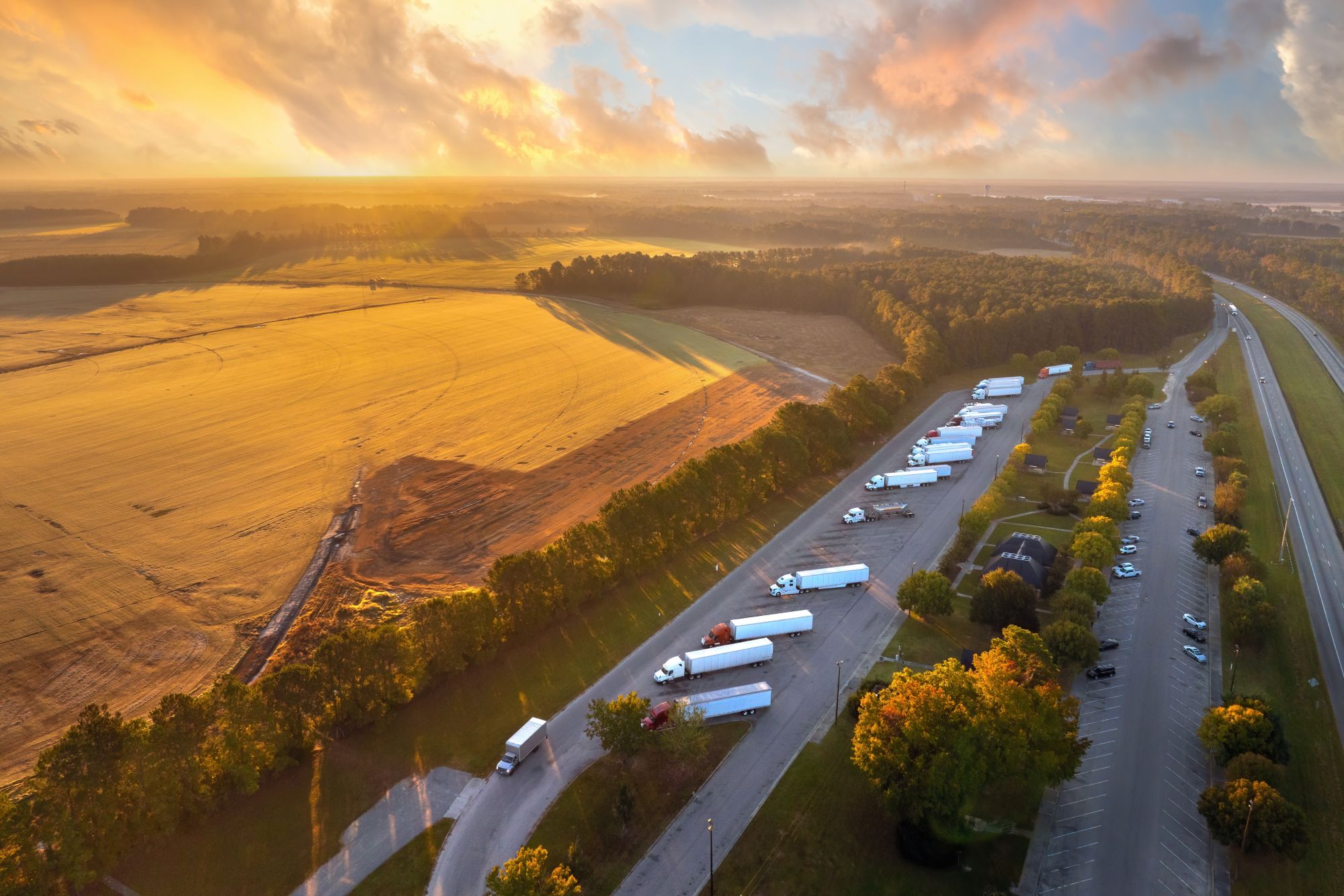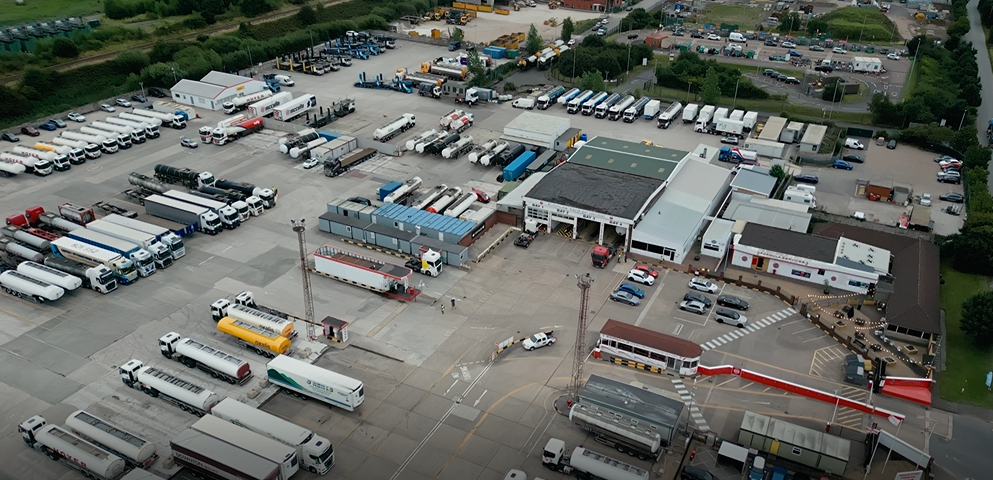
Miranda Blake
Ein Lkw-Fahrer-Leitfaden für den Winter in Europa
Erstellt: 16.10.2024
•
Aktualisiert: 17.09.2025
Lkw-Fahrer stehen in der kalten Jahreszeit vor besonderen Herausforderungen und Pflichten. Es gibt einen Anstieg schwerer Verkehrsunfälle, wobei [33 % der in dieser Zeit geltend gemachten Versicherungsansprüche als schwerwiegend gelten] (https://atha.co.uk/news/why-you-are-more-likely-to-have-a-severe-road-traffic-accident-in-the-winter).
Daher ist die Vorbereitung entscheidend. Hier finden Sie einen Leitfaden, wie Lkw-Fahrer in diesem Winter sowohl auf der Straße als auch in ihrem Fahrerhaus sicher bleiben können.
Navigieren unter stürmischen Bedingungen
Es ist wichtig, langsam zu fahren und einen sicheren Abstand zu anderen Fahrzeugen einzuhalten - besonders in überschwemmten Gebieten. Legen Sie einen niedrigen Gang ein und lassen Sie den Motor laufen.
Die folgenden Tipps helfen auch beim Fahren bei stürmischem Wetter.
- Wenn Sie auf der Wasseroberfläche die Kontrolle verlieren, verlangsamen Sie das Tempo, indem Sie den Fuß vom Gaspedal nehmen - versuchen Sie nicht, plötzlich zu bremsen oder zu lenken.
- Höhere Fahrzeuge sind anfälliger für starken Wind - halten Sie das Lenkrad gut fest und meiden Sie nach Möglichkeit Brücken.
- Fahren Sie mit geöffneten Schiebeplanen, wenn Ihr Lkw leer ist. Auf diese Weise kann sich der Wind nicht so stark verfangen.
Umgang mit Schnee und Eis
Auch bei Eis und Schnee sollten Sie mit reduzierter Geschwindigkeit fahren und den erforderlichen Abstand zum vorausfahrenden Fahrzeug einhalten. Es wird sogar empfohlen, den Bremsweg auf das 10-fache des normalen Abstands zu verlängern - allerdings kann es schwierig sein, dies zu beurteilen. Eine Admiral-Umfrage ergab, dass [Glatteis 10 % der Unfälle im Winter verursacht] (https://atha.co.uk/news/why-you-are-more-likely-to-have-a-severe-road-traffic-accident-in-the-winter). Ob Sie auf Glatteis fahren, können Sie daran erkennen, dass die Straße nass aussieht, aber keine Gischt von anderen Fahrzeugen kommt.
Weitere Tipps für das Fahren im Schnee sind die regelmäßige Inspektion des Lkw und das Mitführen der notwendigen Ausrüstung wie Starthilfekabel und Enteisungswerkzeug vor Fahrtantritt. Außerdem sollten Sie sich immer bewusst sein, welchen Gang Sie einlegen sollten, denn das könnte Sie davor bewahren, die Kontrolle über Ihren Lkw zu verlieren. Fahren Sie auf ebener Strecke im höchstmöglichen Gang. Wenn Sie bergab fahren, nutzen Sie die Motorbremse und fahren Sie in einem niedrigen Gang. Um ein Durchdrehen der Räder zu vermeiden, sollten Sie beim Anfahren einen höheren Gang einlegen - so erhalten Sie die nötige Traktion, um das Fahrzeug zu bewegen.

Gewährleistung der Sichtbarkeit
Da [gefährliche Autobahnen] (https://snapacc.com/hazardous-highways/) und äußere Faktoren die [Sicht] (https://snapacc.com/newsroom/clear-vision-ahead-the-importance-of-eye-care-for-truck-drivers/) negativ beeinflussen und Lkw-Unfälle verursachen, ist die Sicht bei jedem Wetter entscheidend, vor allem wenn es kälter ist. Achten Sie daher auf Risse in Ihrer Windschutzscheibe, da sich diese in den kälteren Monaten schneller ausbreiten können.
Außerdem sollten Sie darauf achten, dass Ihre Scheinwerfer, Ihr Nummernschild und Ihre Windschutzscheibe möglichst gut sichtbar sind. Neben der Reinigung von Schnee und Schmutz ist es ratsam, Ihr Fahrzeug regelmäßig zu waschen, um die Ansammlung von Streusalz zu vermeiden (dies führt zu Korrosion).
Wenn die Sicht schlecht ist und die Bedingungen tückisch werden, ist es am besten, die Straße zu verlassen und an der nächsten Raststätte eine Pause einzulegen. Wenn Sie Ihre [Fahrstunden] (https://snapacc.com/newsroom/discover-the-new-drivers-hours-rules/) überschreiten müssen, können Sie eine Sondergenehmigung für Fahrer in Anspruch nehmen, die unter besonderen Umständen, wie z. B. extremen Wetterbedingungen, festsitzen.
Beurteilung der Profiltiefe von Reifen
Niedrige Temperaturen können sich auch auf die Funktionalität Ihrer Reifen auswirken, da sie zu einem geringeren Luftdruck führen können. Und da abgenutzte Reifen leider den Bremsweg verlängern und die Stabilität auf nassen und vereisten Straßen verringern, führt das geringe Profil zum Rutschen.
Daher ist es ratsam, die Profiltiefe vor jeder Fahrt bei Sturm und anderen widrigen Bedingungen zu überprüfen - so wissen Sie, wann Sie sich um auftretende Probleme kümmern müssen.
Einhaltung der Winterreifenvorschriften
Es ist auch wichtig, die unterschiedlichen Winterreifenvorschriften zu kennen. In einigen Ländern müssen Autofahrer Sandsäcke und Schaufeln mitführen, während in anderen Ländern Schneeketten vorgeschrieben sind. Continental hat einen einfachen [Leitfaden zu den Winterreifenanforderungen] (https://www.continental-tyres.co.uk/b2c/tyre-knowledge/winter-tyre-laws/) für Großbritannien und Europa zusammengestellt.
Ab dem 1. November sind Winterreifen in Deutschland Pflicht:
- Österreich
- Tschechische Republik
- Finnland
- Frankreich
- Litauen
- Serbien
In anderen Ländern sind sie später im Monat oder im Dezember vorgeschrieben oder hängen von den Wetterbedingungen ab. Spikereifen sind zwar in den unten genannten Ländern erlaubt, aber es gibt strenge Vorschriften dafür. Am besten informieren Sie sich vor Ihrer Reise über die Vorschriften des jeweiligen Landes.
- Österreich
- Weißrussland
- Dänemark
- Estland
- Finnland
- Frankreich
- Großbritannien
- Lettland
- Liechtenstein
- Litauen
- Norwegen
- Spanien
- Schweden
- Schweiz
- Türkei
- Ukraine
Mitbringen der benötigten Materialien
Sie müssen auch daran denken, wie Sie sich im Winter versorgen können. Das klingt zwar selbstverständlich, aber stellen Sie sicher, dass Sie ausreichend zu essen und zu trinken haben. Da es in der kalten Jahreszeit häufiger zu Straßensperrungen kommt, können Sie nicht immer eine Raststätte erreichen. Halten Sie einen Snack oder eine Mahlzeit und idealerweise ein heißes Getränk in einer Trinkflasche bereit.
Vor allem wenn Sie keinen Platz zum Ausruhen finden, sollten Sie dafür sorgen, dass Sie sich warm halten können. Nehmen Sie zum Beispiel wiederaufladbare Heizpacks mit. Halten Sie auch immer warme Ersatzkleidung bereit; dies ist besonders hilfreich, wenn die Kleidung durch Aufgaben wie das Entfernen von Schnee von der Windschutzscheibe kalt und nass wird.
Im Idealfall haben Sie ein Winter-Survival-Kit - bestehend aus Lebensmitteln, Getränken, einem tragbaren Handy-Ladegerät, einer Taschenlampe, Decken, einer Warnweste, einer Schaufel und festen Wanderschuhen.
Garantierter Zugang zu Raststätten mit intruck
Auf das Wetter haben Sie zwar keinen Einfluss, aber Sie können sich und andere Verkehrsteilnehmer schützen. Dazu gehört auch, dass Sie so schnell wie möglich einen sicheren Parkplatz finden. Unsere intruck-App oder die [Kartenseite] (https://snapacc.com/map/) zeigen Ihnen nahegelegene Dienstleister sowie Informationen über die von ihnen angebotenen Einrichtungen an.
Sie können die intruck-App noch heute herunterladen, indem Sie auf [diesen Link] klicken (https://intruckapp.com/download/).



